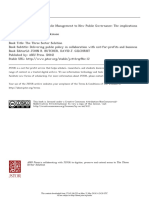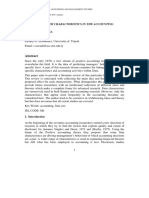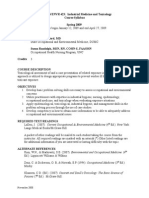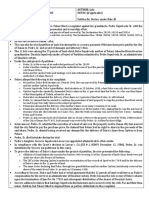Models of Excellence in Government Organizations: e Nal Process 1odels.) Addi
Models of Excellence in Government Organizations: e Nal Process 1odels.) Addi
Uploaded by
Lucian Ionut MihalacheCopyright:
Available Formats
Models of Excellence in Government Organizations: e Nal Process 1odels.) Addi
Models of Excellence in Government Organizations: e Nal Process 1odels.) Addi
Uploaded by
Lucian Ionut MihalacheOriginal Description:
Original Title
Copyright
Available Formats
Share this document
Did you find this document useful?
Is this content inappropriate?
Copyright:
Available Formats
Models of Excellence in Government Organizations: e Nal Process 1odels.) Addi
Models of Excellence in Government Organizations: e Nal Process 1odels.) Addi
Uploaded by
Lucian Ionut MihalacheCopyright:
Available Formats
3()2
Chapter 10/ Executive Management
I-/al C. Rainey and Paula Steinbauer/Galloping Elephants
303
tization of public services generally tend to report
savings that result from privatization, but the results also show a mixed pattern with many instances where no savings were achieved, and with
few findings of the very large savings projected by
some proponents of privatization. The more carefully designed the study, the smaller the reported
savings (e.g., Gill and Rainey 1997). Similarly,
evaluation of the privatization of state-owned enterprises is much more complicated than its aggressive proponents have projected (Durant,
Legge, and Moussios 1998). These limited successes of privatization support Simon's assertion,
quoted at the beginning of this article, that public
organizations can and often do perform as well as
private firms.
Lowery (1997), among others, helps to explain
why one should expect mixed results from certain
types of privatization when he analyzes quasi market failures, such as the failure of a market to develop for the contract (i.e., there may be little
competition for the contract). As Lowery points
out, the aggressive proponents of privatization implicitly rely on the dubious assumption that the bureaucrats who could not manage effectively before
contracting-out suddenly become transformed into
highly efficient and effective managers of the development and monitoring of contracts. The mixed
results suggest that the success of privatization initiatives depends heavily on sound management by
government employees, and they return us to the
questions: When and how do government agencies
and the people in them perform well') Why would
bureaucrats who otherwise have weak incentives
for efficiency, or who otherwise face dysfunctional
incentives and information patterns, be motivated
to have a successful contracting process?
Power Sharing and the Hollow
State
In addition, the extension of privatization arrangements, and the increasingly networked or hollow
state character of many public programs, strains
the depiction of the public bureaucracy as a centralized, retentive, monolithic entity. If so centralized and retentive, why has the bureaucracy
allowed all this privatization, and how could it remain so centralized and retentive if it is sharing
power with so many entities (Ketti 1993; Milward,
Provan, and Else 1993)7 These developments,
then, indicate the need to rethink the more negative depictions of public bureaucracy and to consider theories that explain effective government
agencies.
Business Blunders and Generic Theories
of Management
Business firms produce abundant examples of
waste, inefficiency, blundering, and fraud, even in
the most reputable and admired firms. This raises
the issue of whether market exposure actually
causes business firms to perform more effecti vely
than nonmarker government agencies. A rich tradition in organization and management theory involves a generic perspective on those topics. This
tradition is the idea that distinctions between public
and private, and for-profit and nonprofit organizations amount to stereotypes and oversimplifications (H.G. Rainey 1997, SSff). Many scholars who
study organizations emphasize the commonalities
among organizations, especially among those that
purportedly differ by location in the public and
private sectors. Simon (1998, II), in the assertion
mentioned above and quoted at the outset, provides an example of this perspective. Significantly,
in relation to the later sections of this article, he attributes the prospects for effective public organizations to, among other factors, the presence of
dedicated public servants who are motivated not by
narrow economic self-interest but by organizational loyalty and identification (and by implication, an ideal of public service), Simon also argues
that effective public administration is essential to
democracy. He thus quite dramatically implies the
need to seek explanations and theories of effective
government organizations.
Models of Excellence in
Government Organizations
To develop a theory of effective government
agencies, one obviously has to decide how to proceed. Lowery (1997), while not directly pursuing
models of effective agencies. suggests employing
concepts and methods from economics-based and
public choice theory to analyze some of the oversimplifications of those same approaches. His
analysis of quasi market failures develops useful
concepts for elaborating that discussion. The approach in this article, however, focuses more on
government agencies and their general effectiveness, and it draws more on case studies and empirical research in public administration and
public bureaucracy as well as concepts from organization and management theory. The propositions advanced later will draw on conclusions
from many of the authors on successful leadership and management who are cited above. Some
of those authors concentrate on one part of the
elephant such as leadership, mission, or culture,
and some draw only implicit conclusions about
linkages to organizational effectiveness. The full
group of references is not easily summarized
here.
One subset of the references, however, includes efforts to characterize government agencies that perform efficienrly. These profiles
represent efforts to develop models of excellent
organizations and to specify their attributes. Exhibit 10.2 summarizes some of these profiles. An
elaborate review and critique of these efforts is
beyond the scope of this article, but the row
headings on the left of the exhibit indicate common topics ill the profiles, including aspects of
the agency mission and public orientation (Ineluding public service), leadership and primary
means of managing employees, and task design
and work environment. Especially as summarized in the exhibit, in ways that cannot 00 full
justice to the analyses, the profiles need much
more specification and articulation to move in the
direction of a theory. Yet some of their implica_
tions are clear, and they show up in the propOsi_
tions in Exhibit 10.1 and in the discussion of
them that follows.
------------- ---Also of significance are some omissions in the
implicit models in Exhibit 10.2. (In the parlance
of organizational effectiveness researchers, they
mostly represent infernal process lI1odels.) Addi_
tiona! factors receive emphasis in other research
on agency effectiveness. Wolf (1993) analYzed
forty-four case studies of federal agencies to COn_
struct measures of the agencies' characteristics
and their relationships to the organization's effectiveness. As do most of the profiles in EXhibit
lO.2, his findings indicated the importance ofJead_
ership and sense of mission. In addition, however
he found important a variable representing POlit~
ical autonomy (that included universal Political
support and/or freedom from direction by pOliti_
cal authorities). This variable indicates the im,
penance of relations with oversight authorilies
and other external stakeholders, a topic that receives little or no emphasis in the profiles in Exhibit 10.2. It also suggests the need for a
supportive and delegative role by those authorities
that allows the agency reasonable autonomy to
develop and pursue its mission (cf. Wilson 1989'
Meier 1993a). '
Propositions and a Framework
As we indicated earlier, Exhibit 10.1 states propo_
sitions about effective agencies that draw 011 the
references just cited and on additional references
and examples that are described below. Figure 10.1
provides a diagram that suggests a framework linking these propositions and their component concepts. While Exhibit 10.1 does not clearly posit all
the relationships, it bears the implication that all the
components in Exhibit 10.1 should be positively
related in the more effective agencies. Also, in Fio_
ure 10.1 and in the discussion to follow, some ~f
the relationships are hypothesized so clearly that
they have sharp and challenging implications for
research, theory, and practice.
You might also like
- Free Assignment ContractDocument2 pagesFree Assignment ContractHenryNo ratings yet
- From New Public Management To New Public Governance The Implications For A New Public ServiceDocument21 pagesFrom New Public Management To New Public Governance The Implications For A New Public ServiceIlhamBocorNo ratings yet
- Public Administration: Key Issues Challenging PractitionersFrom EverandPublic Administration: Key Issues Challenging PractitionersNo ratings yet
- Scientific Tendencies in EducationDocument4 pagesScientific Tendencies in EducationAiza Jamito100% (2)
- Charla Krupp - How To Never Look Fat Again Over 1,000 Ways To Dress Thinner - Without DietingDocument316 pagesCharla Krupp - How To Never Look Fat Again Over 1,000 Ways To Dress Thinner - Without DietingGabriela Urias Avalos100% (2)
- KitcheN Utensils Lesson Plan 7Document2 pagesKitcheN Utensils Lesson Plan 7Nheia Mheia Ramsenitsirc89% (9)
- Schick 1Document15 pagesSchick 1kaligelisNo ratings yet
- The Role of Government Incorporate Governance Perspectives From The UkDocument34 pagesThe Role of Government Incorporate Governance Perspectives From The UkDita putri AdilaNo ratings yet
- Network Forms of Organization PDFDocument22 pagesNetwork Forms of Organization PDFJess OpianggaNo ratings yet
- Almadi (2015)Document11 pagesAlmadi (2015)IvankaNo ratings yet
- Good Government Means Different Things in Different CountriesDocument42 pagesGood Government Means Different Things in Different CountriesLuis Gómez CastroNo ratings yet
- Network Forms of OrganizationDocument22 pagesNetwork Forms of OrganizationSandro RolakNo ratings yet
- Who Fills The Global Governance Gap? Rethinking The Roles of Business and Government in Global GovernanceDocument51 pagesWho Fills The Global Governance Gap? Rethinking The Roles of Business and Government in Global GovernanceFelipe RodriguesNo ratings yet
- Corporate Political Activity A LiteraturDocument20 pagesCorporate Political Activity A LiteraturSellyNo ratings yet
- How State-owned Enterprises Drag on Economic Growth: Theory and Evidence from ChinaFrom EverandHow State-owned Enterprises Drag on Economic Growth: Theory and Evidence from ChinaNo ratings yet
- Assignment Feedback Form: Student Name Student ID Code QM E - Mail Module DetailsDocument4 pagesAssignment Feedback Form: Student Name Student ID Code QM E - Mail Module DetailsstephenjameswhitworthNo ratings yet
- Nig Ethics IntegrityDocument23 pagesNig Ethics IntegrityFlorin Marius PopaNo ratings yet
- Strategic Managemment Perry Ring AMR Apr 1985Document12 pagesStrategic Managemment Perry Ring AMR Apr 1985Anderson De Oliveira ReisNo ratings yet
- Mpa-13 - emDocument17 pagesMpa-13 - emarun1974No ratings yet
- Unit 06Document72 pagesUnit 06chaitali.chatterjee12345No ratings yet
- Management Controls, Their Limitations, & Nature of Social Constraint v.2Document23 pagesManagement Controls, Their Limitations, & Nature of Social Constraint v.2Palak RoseNo ratings yet
- Comparing Public and Private OrganizationsDocument13 pagesComparing Public and Private OrganizationsdfasdfadssadfasdfsdNo ratings yet
- 3888-Article Text-20534-1-10-20210521Document34 pages3888-Article Text-20534-1-10-20210521mohsenNo ratings yet
- Policy Analysis Concepts and Practice (Weimer y Vining, 2010, Cap 13)Document18 pagesPolicy Analysis Concepts and Practice (Weimer y Vining, 2010, Cap 13)aareliss rojasNo ratings yet
- Comparing Private and Public Management Meirer - O'TooleDocument18 pagesComparing Private and Public Management Meirer - O'TooleBruno SilvaNo ratings yet
- UC Berkeley Previously Published WorksDocument56 pagesUC Berkeley Previously Published WorksBhushi ShushiNo ratings yet
- Privatization in India Issues and EvidenceDocument18 pagesPrivatization in India Issues and EvidencePradeep Kumar RevuNo ratings yet
- Volatality Measure Page No 10Document35 pagesVolatality Measure Page No 10Imran YousafNo ratings yet
- Amable Palombarini SocioEconomic ReviewDocument21 pagesAmable Palombarini SocioEconomic ReviewJavier SolanoNo ratings yet
- Development Management Edited MaterialDocument60 pagesDevelopment Management Edited Materialessajemal77No ratings yet
- 1 Verhoest Et Al Autonomy ConceptualDocument40 pages1 Verhoest Et Al Autonomy Conceptualmhalkot11No ratings yet
- Allen 2014 Business Systems Theory and Employment RelationsDocument48 pagesAllen 2014 Business Systems Theory and Employment RelationsKrishna RajputNo ratings yet
- Beyond Markets Sociology Street Level Bureaucracy and The Management of The Public SectorDocument20 pagesBeyond Markets Sociology Street Level Bureaucracy and The Management of The Public SectorPaul JimenezNo ratings yet
- The Impact of Red Tape On Governmental Performance An Empirical Analysis.Document26 pagesThe Impact of Red Tape On Governmental Performance An Empirical Analysis.marielkuaNo ratings yet
- Briefly Explain The Origin, Development, Rationale, Theories and Key Actors in GovernanceDocument23 pagesBriefly Explain The Origin, Development, Rationale, Theories and Key Actors in GovernanceYeshihareg AlemuNo ratings yet
- LEWIS Politics Performance Measure 1-s2.0-S1449403515000041-MainDocument12 pagesLEWIS Politics Performance Measure 1-s2.0-S1449403515000041-MainRodrigo Rodrigues S AlmeidaNo ratings yet
- HowtoMoveAhead 07 632 Final-1Document26 pagesHowtoMoveAhead 07 632 Final-1Giorgos BabalisNo ratings yet
- Body of Discussion - AnalysisDocument4 pagesBody of Discussion - AnalysisFatihah AnuarNo ratings yet
- Hall Thelen SocioEconomic ReviewDocument28 pagesHall Thelen SocioEconomic ReviewJavier SolanoNo ratings yet
- Hill & Jones 1992Document25 pagesHill & Jones 1992LEO GAONo ratings yet
- JOM 06 CG Legitimacy - Title Page AbstractDocument38 pagesJOM 06 CG Legitimacy - Title Page AbstractEduardus Beni SulistyoNo ratings yet
- Fuchs, D., & Lederer, M. M. L. (2007) - The Power of Business, Business and Politics, 9 (3) .Document19 pagesFuchs, D., & Lederer, M. M. L. (2007) - The Power of Business, Business and Politics, 9 (3) .RocioNo ratings yet
- Public and Private ManagementDocument27 pagesPublic and Private Managementfinalita alifahNo ratings yet
- The Role of Firm Characteristics in The AccountingDocument17 pagesThe Role of Firm Characteristics in The AccountingimadalinajiNo ratings yet
- Social Capital, Trust and Participative Public Service DeliveryDocument10 pagesSocial Capital, Trust and Participative Public Service DeliverymahamayaviNo ratings yet
- Puente Schneider Review 2020Document25 pagesPuente Schneider Review 2020Irene RillaNo ratings yet
- 2012 Bookmatter InternationalBusinessDocument5 pages2012 Bookmatter InternationalBusinessSuman ChaudharyNo ratings yet
- Governance and Oublic AdministrationDocument56 pagesGovernance and Oublic AdministrationasrifaiNo ratings yet
- Investigation 1Document42 pagesInvestigation 1fifiNo ratings yet
- Stakeholder Agency TheoryDocument24 pagesStakeholder Agency TheoryLaura ArdilaNo ratings yet
- New Public Management A Tribute To Margaret ThatcherDocument6 pagesNew Public Management A Tribute To Margaret ThatcherAlexander DeckerNo ratings yet
- Acemoglu, Modeling Inefficient InstitutionsDocument55 pagesAcemoglu, Modeling Inefficient Institutions88205489No ratings yet
- The Firm As A Subeconomy: JLEO, V15 N1Document29 pagesThe Firm As A Subeconomy: JLEO, V15 N1LucianoNo ratings yet
- 70093864Document8 pages70093864Mahesh T MadhavanNo ratings yet
- Capabilities and Strategic Entrepreneurship in Public OrganizationsDocument22 pagesCapabilities and Strategic Entrepreneurship in Public OrganizationsOdonchimeg MyagmarsurenNo ratings yet
- Governanceas PADocument56 pagesGovernanceas PAserryserry362No ratings yet
- New Public GovernanceDocument21 pagesNew Public GovernanceSatyabrat DasNo ratings yet
- Corporate Governance Vs Government GovernanceDocument40 pagesCorporate Governance Vs Government GovernanceAstri RirinNo ratings yet
- Assignment Course Code: MS - 92 Course Title: Management of Public Enterprises Assignment Code: MS-92/TMA/SEM - I/2017Document14 pagesAssignment Course Code: MS - 92 Course Title: Management of Public Enterprises Assignment Code: MS-92/TMA/SEM - I/2017Rajni KumariNo ratings yet
- Sustainable Management of Self Financing Public AssetsDocument30 pagesSustainable Management of Self Financing Public AssetsDinkle KingNo ratings yet
- Corp ProjectDocument2 pagesCorp ProjectRatna SupriyaNo ratings yet
- Corporate Governance Lessons from Transition Economy ReformsFrom EverandCorporate Governance Lessons from Transition Economy ReformsNo ratings yet
- Public Capitalism: The Political Authority of Corporate ExecutivesFrom EverandPublic Capitalism: The Political Authority of Corporate ExecutivesNo ratings yet
- KESSV2 Ktag CableDocument1 pageKESSV2 Ktag CableLucian Ionut MihalacheNo ratings yet
- Benoit FrenchPolitics 2006Document15 pagesBenoit FrenchPolitics 2006Lucian Ionut MihalacheNo ratings yet
- Release NewsDocument205 pagesRelease NewsLucian Ionut MihalacheNo ratings yet
- Scan 0001jyruyrfDocument1 pageScan 0001jyruyrfLucian Ionut MihalacheNo ratings yet
- Annex Euro GapDocument12 pagesAnnex Euro GapLucian Ionut MihalacheNo ratings yet
- Downloaded LicensesDocument1 pageDownloaded LicensesLucian Ionut MihalacheNo ratings yet
- Addressing Modes of 8086Document42 pagesAddressing Modes of 8086Anjana P NairNo ratings yet
- United Church of Christ in The Philippines: Second Sunday of EasterDocument2 pagesUnited Church of Christ in The Philippines: Second Sunday of EasterEmjhay SwakidaNo ratings yet
- Cost AuditDocument8 pagesCost AuditShaikh SuhailNo ratings yet
- Quarter 4 PostDocument6 pagesQuarter 4 Postrecachohayden40No ratings yet
- Jainism ExplainedDocument91 pagesJainism Explainedtwinklelee1234100% (1)
- Numeracy Guiding Document and Action PlanDocument42 pagesNumeracy Guiding Document and Action Plandeguzmanrichard092No ratings yet
- Panchanga-Kannada-2019 Drik Panchang Kannada Calendar v1.0.1Document25 pagesPanchanga-Kannada-2019 Drik Panchang Kannada Calendar v1.0.1Trading AmibrokerNo ratings yet
- PHNU 423/ENVR 423: Industrial Medicine and Toxicology Course Syllabus Spring 2009Document3 pagesPHNU 423/ENVR 423: Industrial Medicine and Toxicology Course Syllabus Spring 2009Che Ainil ZainodinNo ratings yet
- Dec Maths 3Document10 pagesDec Maths 3SIDRANo ratings yet
- Republic Act No 10707 Probation LawDocument3 pagesRepublic Act No 10707 Probation LawHumility Mae FrioNo ratings yet
- Flywheel ProblemsDocument51 pagesFlywheel Problemsgiriaj kokareNo ratings yet
- Lesson Activity 1Document7 pagesLesson Activity 1aresthesoldier100% (1)
- What-if/Checklist Hazards Analysis ReportDocument4 pagesWhat-if/Checklist Hazards Analysis ReportArash IlbagiNo ratings yet
- Aztecs Primary Homework HelpDocument4 pagesAztecs Primary Homework Helpcfgmd6g1100% (1)
- Vander Vaal ForcesDocument132 pagesVander Vaal Forcesmanisha maniNo ratings yet
- C# Architecture of ADODocument5 pagesC# Architecture of ADOravatsinhsNo ratings yet
- NLE Exam Drill 2 (Q Only 100)Document13 pagesNLE Exam Drill 2 (Q Only 100)Epaphras Joel MilitarNo ratings yet
- Exception (Waiver of Immunity) A. Express ConsentDocument16 pagesException (Waiver of Immunity) A. Express ConsentAira AmorosoNo ratings yet
- A Guidline For Banking ReportDocument3 pagesA Guidline For Banking ReportSohel MahmudNo ratings yet
- Warm Up and Cool DownDocument4 pagesWarm Up and Cool Downapi-315123529No ratings yet
- Discovering TutDocument8 pagesDiscovering TutHarshit SinghNo ratings yet
- Law2485 Semc 2021 Sgs g02 Cry-me-A-riverDocument15 pagesLaw2485 Semc 2021 Sgs g02 Cry-me-A-riverLe NganNo ratings yet
- Polio PDFDocument14 pagesPolio PDFInomy Claudia Katherine Imbiri50% (2)
- Math Book ReportDocument11 pagesMath Book Reportapi-391823256No ratings yet
- Restaurant Management System: Software Requirement SpecificationsDocument21 pagesRestaurant Management System: Software Requirement SpecificationsAthar AbbasNo ratings yet
- 050 Sepulveda V PelaezDocument2 pages050 Sepulveda V PelaezTristan HaoNo ratings yet































































































